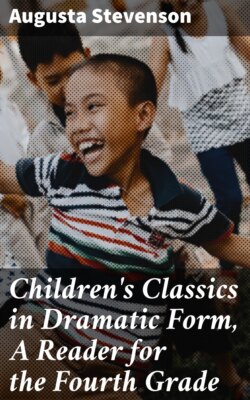Читать книгу Children's Classics in Dramatic Form, A Reader for the Fourth Grade - Augusta Stevenson - Страница 3
На сайте Литреса книга снята с продажи.
FOREWORD
ОглавлениеTable of Contents
This book is intended to accomplish three distinct purposes: first, to arouse a greater interest in oral reading; second, to develop an expressive voice—sadly lacking in the case of most Americans; and third, to give freedom and grace in the bodily attitudes and movements which are involved in reading and speaking. The stories given are for the most part adaptations of favorite tales from folklore—Andersen, Grimm, Aesop, and the Arabian Nights having been freely drawn upon.
Children are dramatic by nature. They are for the time the kings, the fairies, and the heroes that they picture in their imaginations. They are these characters with such abandon and with such intense pleasure that the on-looker must believe that nature intended that they should give play to this dramatic instinct, not so much formally, with all the trappings of the man-made stage, but spontaneously and naturally, as they talk and read. If this expressive instinct can be utilized in the teaching of reading, we shall be able both to add greatly to the child's enjoyment and to improve the quality of his oral reading. In these days when so many books are hastily read in school, there is a tendency to sacrifice expression to the mechanics and interpretation of reading. Those acquainted with school work know too well the resulting monotonous, indistinct speech and the self-conscious, listless attitude which characterize so much of the reading of pupils in grades above the third. It is believed that this little book will aid in overcoming these serious faults in reading, which all teachers and parents deplore. The dramatic appeal of the stories will cause the child to lose himself in the character he is impersonating and read with a naturalness and expressiveness unknown to him before, and this improvement will be evident in all his oral reading, and even in his speech.
The use of the book permits the whole range of expression, from merely reading the stories effectively, to "acting them out" with as little, or as much, stage-setting or costuming as a parent or teacher may desire. The stories are especially designed to be read as a part of the regular reading work. Many different plans for using the book will suggest themselves to the teacher. After a preliminary reading of a story during the study period, the teacher may assign different parts to various children, she herself reading the stage directions and the other brief descriptions inclosed in brackets. The italicized explanations in parentheses are not intended to be read aloud; they will aid in giving the child the cue as to the way the part should be rendered. After the story has been read in this way, if thought advisable it can be played informally and simply, with no attempt at costuming or theatric effects. It will often add to the interest of the play to have some of the children represent certain of the inanimate objects of the scene, as the forest, the town gate, a door, etc. Occasionally, for the "open day," or as a special exercise, a favorite play may be given by the children with the simplest kind of costuming and stage-setting. These can well be made in the school as a part of the manual training and sewing work. In giving the play, it will generally be better not to have pupils memorize the exact words of the book, but to depend upon the impromptu rendering of their parts. This method will contribute more largely to the training in English.
The best results will usually be obtained by using these stories in the fourth grade. In some schools, however, the stories in the first part of the book may profitably be used in the third grade.
The author has been led to believe from her own experience and from her conversation with many other teachers that there is a pronounced call for this kind of book. She therefore hopes that in the preparation of this book she may have been of service to the teachers and children who may be led to use it.
A. S.
ILLUSTRATIONS
"The Moon Changes Into the Red Beard of The Old Soldier"
The Travellers and the Hatchet
"We Have Lost Our Donkey"
What the Goodman Does Is Always Right
The Cat and the Mouse
"'Tis Sinking! What Shall I Do?"
The Ugly Duckling
"A Thousand Pieces at Least!"
The Two Countrymen
"Help! Help!"
"The Prince Sees the Three Great-Aunts"
